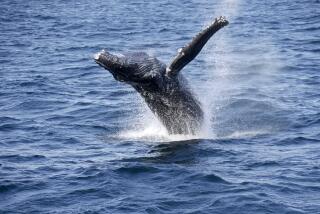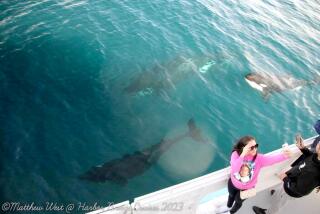Boston Harbor Cleanup Runs Afoul of Nature : Outfall will dump waste water into ecosystem used by five species of endangered whales.
BOSTON — Since the days when Bay State revolutionaries flung crates of tea into Boston Harbor, this historic body of water has been awash both in controversy and in waste.
For more than a century, Boston and its surrounding communities have been spewing their sewage into Boston Harbor, making it one of the nation’s most polluted bodies of water and an object of derision.
But now, several years into a $4.3-billion effort to clean its harbor, Boston’s anti-pollution plan appears on a collision course with a conflicting environmental priority--protecting some of the world’s most endangered whales.
The Boston Harbor outfall pipe is a tunnel 25 feet in diameter that by 1996 would carry the lightly treated sewage of Boston and 42 surrounding communities almost 10 miles into Massachusetts Bay. The quality of the sewage will improve by the year 2000 from a network of new treatment facilities.
The problem: The sewage water will be dumped in an ecosystem used by five species of endangered whales, including the most precarious, the North American right whale. Now down to a population of no more than 300, right whales use Massachusetts and Cape Cod bays as a nursery ground, where mothers and calves feed for at least three months in the summer and fall.
Some experts fear that a concentrated dose of pollutants could push the right whales to extinction. Fresh water and organic nutrients pumped into the bay could disrupt the whales’ food supply and possibly cause unsightly algae blooms or even deadly red tides along Cape Cod’s famous bayside coastal communities. The contaminants could accumulate in the whales’ blubber, possibly leading to disease or birth defects.
Fears are compounded by the limits of scientists’ knowledge about the elusive right whales. Researchers have little understanding of the whales’ migration patterns, reproductive behaviors or cumulative exposures to environmental hazards, and prospects are slim that such information can be gathered soon. With research funds scarce, only two full migration seasons remain before the sewage is to begin flowing.
“We’re babes in the woods about virtually all of this,” said Scott Kraus of the New England Aquarium’s Right Whale Research Center. “If you screw up, the consequences are disastrous. You don’t get a second chance if you lose the right whale in the North Atlantic, and that makes me nervous as hell.”
At the same time, Kraus and other whale experts have been wary of efforts to halt or delay the project, which would leave Boston Harbor befouled, with continuing consequences for sea life throughout Massachusetts Bay.
“You can’t put up a wall between the harbor and the bay and leave Boston Harbor a fetid mess,” said Dr. Charles (Stormy) Mayo of Provincetown’s Center for Coastal Studies.
Acting under the Endangered Species Act, the Commerce Department’s National Marine Fisheries Service concluded in September that on the “best available information,” which all admit is scarce, the sewage would not place endangered species of whales or sea turtles in jeopardy.
But the Commerce Department’s marine fisheries experts did acknowledge the project “may affect” the endangered species. “In situations where there’s conflicting credible scientific evidence or where there’s uncertainty regarding impact, a jeopardy conclusion is difficult to justify,” the government said.
That reasoning turns the intent of the Endangered Species Act “totally upside-down,” said Eric Glitzenstein, an attorney for the Bays’ Legal Fund. In uncertain cases, the act requires the federal government to give the benefit of the doubt to species-protection measures.
Bays’ Legal Fund has sued to stop construction pending further studies, but, in July, a federal judge turned away the request to halt work. The group is pursuing an appeal and is lobbying the Environmental Protection Agency to reconsider its support for the project.
Piping sewage into the open ocean represents what many environmentalists call an outdated approach: that “dilution is the solution to pollution.”
“That’s the easiest argument for municipalities to raise to get away from doing something,” said Lisa Weil, a Santa Monica-based analyst with the American Oceans Campaign. “And there’s a lot of science out there that says that’s not the solution at all. There is some dilution factor. But it’s not the ultimate solution to waste water treatment.”
More to Read
Sign up for Essential California
The most important California stories and recommendations in your inbox every morning.
You may occasionally receive promotional content from the Los Angeles Times.











